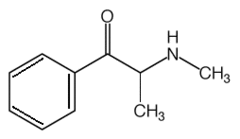Methcathinone
Methcathinone is an addictive recreational drug that is cheap and simple to synthesize. It is usually snorted, but can be smoked, injected, or taken orally. Methcathinone is currently a DEA Schedule I chemical. more...
History
Methcathinone was first synthesized in Germany in 1928. It was used in the Soviet Union during the 1930s and 1940s as an anti-depressant. Since the 1960s, methcathinone has been used as a recreational drug in the Soviet Union.
Circa 1994, the United States government informed the UN Secretary-General of its opinion that methcathinone should be added to Schedule I of the Convention on Psychotropic Substances.
Chemistry
Methcathinone is very similar in structure to cathinone, a stimulant alkaloid occurring in the shrub Catha edulis (Khat), the synthetic stimulant methamphetamine, and other phenethylamines.
Methcathinone has a single asymmetric carbon atom, thus yielding enantiomeric + and - forms. Chemical Abstract Services registry numbers for the racemic base and hydrochloride forms are 5650-44-2 and 49656-78-2, respectively. The Chemical Abstract Services registry numbers for the base and hydrochloride forms of the S absolute stereochemical configuration are 112117-24-5 and 66514-93-0, respectively.
Various names for methcathinone include:
- 2-(methylamino)-propiophenone
- α-methylamino-propiophenone
- α-N-methyl-aminopropiophenone
- 2-(methylamino)-1-phenylpropan-1-one
- N-methylcathinone
- N-monomethylcathinone
- Methylcathinone
- AL-464 (L isomer)
- AL-422 (racemate)
- AL-463 (D-isomer)
- UR1431
- UR(W)1431
Methcathinone hydrochloride increases spontaneous rodent locomotor activity, potentiates the release of radio-labelled dopamine from dopaminergic nerve terminals in the brain, and causes appetite suppression.
Methcathinone is most commonly made by the oxidation of ephedrine. Oxidation of ephedrine to methcathinone requires almost zero chemistry experience, making it easy to synthesize. Potassium permanganate (KMnO4) is most the commonly used as the oxidant.
Methcathinone can also be synthesized via the oxidation of l-ephedrine using sodium dichromate and sulfuric acid. This process is just as simple as oxidizing the ephedrine with potassium permanganate.
Synthesizing methcathinone from either potassium permanganate or various chromates is considered undesirable because of the low yields. A method that yields more methcathinone is oxidizing ephedrine with sodium hypochlorite.
Methcathinone acts on the body & brain much like methamphetamine & amphetamine do.
Effects
The effects of methcathinone are similar to those of methamphetamine, but generally less intense, and often more euphoric. The effects have been compared to those of cocaine, since it commonly causes hypertension (elevated blood pressure) and tachycardia (elevated heart rate). Reported effects include:
Read more at Wikipedia.org



